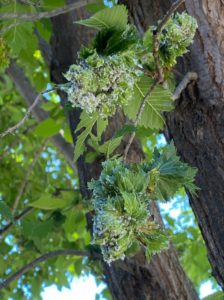The Woolly Elm Aphid overwinters in the egg stage in furrows of the bark of American elms. Early in May, as the leaves on Elm trees begin emerge and open up, aphids hatch and begin feeding on the underside of young leaves which causes the leaves to curl and form an “envelope” that protects the aphids (making spraying with chemicals ineffective). After a few weeks of feeding the aphids mature and produce a new generation aphids that also feed within the protected shelter of the leaf. In June these aphids develop wings and leave the protection of the Elm leaf to find Saskatoon shrubs (as this is the alternate host it requires to complete it’s life cycle). The now winged aphids move to the underside of a leaf on the Saskatoons and each aphid produces yet another generation of young. These aphids descend to the roots of the saskatoon where they feed directly on the roots. Through the rest of the summer the aphids produce large colonies on the roots. The base of the Saskatoons can start to look blue or purple in color due to the secretions of the aphids. In August, they leave the roots and move back to the Elms where they produce more young that search for protected sites in the furrows of the bark and lay eggs that will overwinter
Tree Damage
Damage occurs as the aphid pierces tree tissue and starts removing sap from the host. On Elm, the aphid causes the leaves curl which creates an unsightly look and these leaves persist throughout the year, however there is very little damage done to the tree. The aphids secrete Honeydew which is a sweet, sticky substance which be a big nuisance if you have a walkway, patio or car nearby. On saskatoons, the damage is much worse. Whole roots can be quickly killed and on young plants a severe infestation can kill the plants.
Control Measures
There are several options for treating aphids on elms but few none for treating saskatoon. Treating Elm trees or removing them entirely does not seem to effect aphid infestations of Saskatoon plants as they can travel very large distances.


